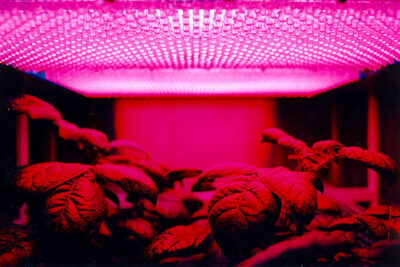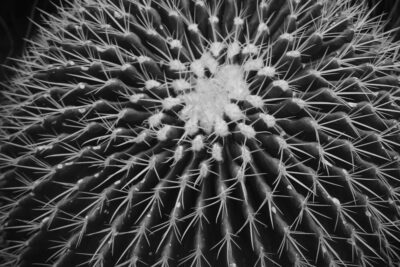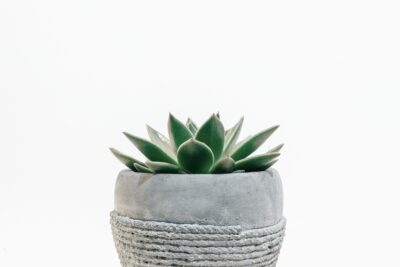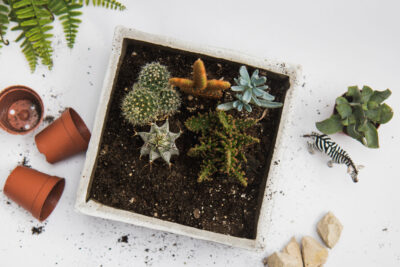
Can Environmental Factors Influence the Color of Succulents?

Succulents are popular plants known for their ability to store water in their leaves, stems, and roots. They come in a variety of shapes and sizes, but one of the most fascinating aspects of succulents is their color. From vibrant greens to deep purples and even bright reds, succulents can display a wide range of hues that add to their visual appeal. But have you ever wondered if environmental factors can influence the color of succulents?
We will explore the role of environmental factors in determining the color of succulents. We will discuss how factors such as light exposure, temperature, and water availability can impact the pigmentation of succulents. Additionally, we will delve into the mechanisms behind these color changes and examine some specific examples of succulent species that are particularly sensitive to environmental influences. By the end of this article, you will have a better understanding of how the environment can shape the color palette of these unique and beautiful plants.
- Yes, environmental factors can influence the color of succulents
- Light exposure can affect the color of succulents
- Temperature variations can impact the color of succulents
- Watering frequency can influence the color of succulents
- Nutrient levels in the soil can affect the color of succulents
- Stress from environmental conditions can change the color of succulents
- Environmental factors such as light exposure can have an impact on the color of succulents
- Temperature variations can cause changes in the color of succulents
- The frequency of watering can influence the color of succulents
- Nutrient levels in the soil play a role in determining the color of succulents
- Environmental stress can lead to changes in color in succulents
- Frequently Asked Questions
Yes, environmental factors can influence the color of succulents
Succulents are known for their vibrant and diverse colors, ranging from shades of green to hues of purple, pink, and even red. While genetics play a significant role in determining the natural color of succulents, environmental factors can also have a profound impact on their pigmentation.
1. Light intensity and quality:
The amount and quality of light a succulent receives can greatly affect its color. Succulents exposed to intense sunlight tend to develop deeper and more vibrant colors. This is because sunlight contains a wide spectrum of colors, including blue and ultraviolet light, which promote the production of pigments such as anthocyanins and carotenoids. These pigments are responsible for the red, purple, and orange hues commonly seen in succulents.
2. Temperature:
 Optimal Growing Conditions for Succulents: Sun or Shade?
Optimal Growing Conditions for Succulents: Sun or Shade?The temperature at which a succulent is grown can also influence its color. Some succulents, like the Echeveria 'Perle von Nürnberg', exhibit a phenomenon called "blushing" when exposed to cool temperatures. Blushing is characterized by the development of pink or purple hues on the succulent's leaves. In contrast, succulents grown in warm climates may retain their green coloration.
3. Water availability:
The availability of water can impact the color of succulents as well. Under drought or water stress conditions, succulents may undergo a process called "succulent stress coloring." This occurs when the plant produces pigments as a protective mechanism against excessive sunlight and water loss. As a result, succulents may develop more intense colors, such as deep red or purple, in response to water scarcity.
4. Nutrient levels:
The availability of certain nutrients in the soil can also affect the color of succulents. For instance, succulents grown in nitrogen-deficient soil may exhibit a more intense red or purple coloration due to an increased production of anthocyanins. On the other hand, succulents grown in nutrient-rich soil may have a more vibrant green color.
Conclusion:
While genetics determine the baseline color of succulents, environmental factors can significantly influence their pigmentation. Light intensity and quality, temperature, water availability, and nutrient levels all play a role in shaping the color palette of these fascinating plants. By understanding and manipulating these factors, succulent enthusiasts can create stunning displays of colorful and unique succulents.
 Maximum Size of Succulent Plants in Optimal Growing Conditions
Maximum Size of Succulent Plants in Optimal Growing ConditionsLight exposure can affect the color of succulents
When it comes to succulents, their color is not only determined by their genetic makeup but also by environmental factors such as light exposure. The amount and intensity of light that succulents receive can have a significant impact on their pigmentation and overall coloration.
Strong sunlight can often result in succulents developing vibrant and intense colors. The higher levels of light exposure stimulate the production of pigments, such as anthocyanins and carotenoids, which are responsible for the various hues seen in succulents. These pigments act as natural sunscreens, protecting the plants from excessive sunlight and potential damage.
Effects of light intensity
The intensity of light plays a crucial role in determining the color of succulents. Succulents exposed to high-intensity light, such as direct sunlight, tend to exhibit more saturated and vivid colors. This is especially true for succulents with red, purple, or orange pigmentation. The intense light triggers the production of anthocyanins, which give these plants their bold and eye-catching hues.
On the other hand, succulents kept in low light conditions or partial shade may display a more muted or pale coloration. Insufficient light can result in reduced pigment production, leading to a less vibrant appearance. These succulents may appear green or pale yellow, lacking the intense pigmentation seen in their sun-exposed counterparts.
Effects of light duration
The duration of light exposure also influences the color development in succulents. Succulents that receive shorter durations of sunlight may exhibit slower or less pronounced color changes. For instance, succulents exposed to shorter periods of direct sunlight during the day, such as those placed indoors or in shaded areas, may take longer to develop their full-color potential.
However, it is essential to strike a balance when it comes to light exposure. While succulents thrive in bright light, excessive or prolonged exposure to intense sunlight can lead to sunburn and damage the plants. It is crucial to monitor the light conditions and adjust accordingly to ensure optimal growth and coloration.
The color of succulents can be influenced by environmental factors, with light exposure being a key determinant. The intensity and duration of light play significant roles in shaping the pigmentation and overall coloration of succulents. By providing the right balance of light, succulent enthusiasts can enhance and appreciate the stunning array of colors displayed by these unique plants.
 Choosing Low-Maintenance Outdoor Perennial Succulents
Choosing Low-Maintenance Outdoor Perennial SucculentsTemperature variations can impact the color of succulents
One fascinating aspect of succulents is their ability to adapt and change their appearance based on environmental factors. One such factor that can have a significant impact on the color of succulents is temperature. Temperature variations, both hot and cold, can play a crucial role in determining the hues and shades that succulents exhibit.
When exposed to higher temperatures, succulents often develop vibrant and intense colors. The heat stimulates the production of pigments in the plants, leading to striking shades of red, orange, or purple. These warm hues not only add visual interest but also serve as a protective mechanism for the plants.
On the other hand, colder temperatures can result in succulents displaying more muted and subtle tones. The lower temperatures slow down the pigmentation process, causing succulents to appear paler or even turn a shade of green. This adaptation helps the plants blend in with their surroundings and protect them from excessive sunlight and potential damage.
It's important to note that succulents are incredibly resilient and can withstand a wide range of temperatures. However, extreme fluctuations in temperature can be detrimental to their health. It is crucial to provide succulents with a suitable environment and ensure they are not exposed to prolonged periods of extreme heat or cold.
To best control the color of your succulents, consider monitoring the temperature levels in their environment. Providing a consistent and moderate temperature range can help maintain and enhance the desired coloration.
Temperature plays a significant role in determining the color of succulents. By understanding how temperature variations impact their appearance, succulent enthusiasts can create the ideal conditions for their plants to thrive and showcase their vibrant colors.
 Is Lack of Sunlight Killing My Succulent?
Is Lack of Sunlight Killing My Succulent?Watering frequency can influence the color of succulents
One of the key environmental factors that can influence the color of succulents is the watering frequency. Succulents are known for their ability to store water in their leaves, stems, and roots. This adaptation allows them to survive in arid environments with limited rainfall.
When succulents are watered too frequently, their growth can be stimulated, resulting in a lighter color. This is because the excess water encourages the succulent to produce more chlorophyll, the pigment responsible for the green color in plants. As a result, the succulent may appear more vibrant and lighter in color.
On the other hand, if succulents are not watered enough, they may become stressed and their color can darken. This is because the succulent conserves water by reducing its metabolic activity and slowing down its growth. As a result, the chlorophyll production decreases, causing the succulent to appear darker and potentially more muted in color.
It's important to note that different succulent species have varying water requirements. Some succulents, like the Echeveria, prefer infrequent watering and can tolerate dry conditions, while others, like the Aloe Vera, require more regular watering. Understanding the specific watering needs of your succulent can help you maintain its desired color and overall health.
In addition to watering frequency, other environmental factors such as sunlight exposure and temperature can also influence the color of succulents. By providing the optimal conditions for your succulent's specific needs, you can help enhance its natural color and ensure its long-term well-being.
Nutrient levels in the soil can affect the color of succulents
Succulents are known for their vibrant and diverse colors, ranging from deep greens to vibrant pinks and purples. While genetics play a significant role in determining the color of succulents, environmental factors can also have a profound impact on their pigmentation. One such factor is the nutrient levels in the soil.
 Optimal Outdoor Climate for Succulents: Temperature Range Tips
Optimal Outdoor Climate for Succulents: Temperature Range TipsSoil composition and nutrient availability are crucial for the growth and development of plants, including succulents. Different nutrients play specific roles in plant metabolism and can influence various aspects of plant physiology, including coloration. Lack or excess of certain nutrients can lead to color changes in succulents.
Nutrients that affect succulent coloration
1. Nitrogen: Nitrogen is essential for the production of chlorophyll, the pigment responsible for green coloration in plants. Insufficient nitrogen levels can result in pale or yellowish succulents, while excessive nitrogen can cause dark green or even blackish foliage.
2. Phosphorus: Phosphorus is vital for energy transfer and cell division in plants. Adequate phosphorus levels contribute to healthy succulent growth and vibrant colors. A deficiency in phosphorus can cause stunted growth and dull, faded colors in succulents.
3. Potassium: Potassium is involved in various physiological processes, including water regulation and photosynthesis. Succulents with adequate potassium levels display vivid colors, while potassium deficiency may lead to color fading or browning of the leaves.
4. Iron: Iron is crucial for the synthesis of chlorophyll and other pigments in plants. Insufficient iron can result in pale or yellowish succulents, as chlorophyll production is impaired. However, excessive iron can cause toxicity and damage the plant's roots.
How to ensure proper nutrient levels for colorful succulents
1. Soil testing: Conduct a soil test to determine the nutrient levels in your succulent's growing medium. This will help identify any deficiencies or excesses that need to be addressed.
2. Balanced fertilizer: Use a balanced fertilizer specifically formulated for succulents. These fertilizers provide a mix of essential nutrients in appropriate ratios to promote healthy growth and vibrant colors.
 The Ideal Amount of Sunlight for Succulent Growth: A Guide
The Ideal Amount of Sunlight for Succulent Growth: A Guide3. Organic matter: Incorporate organic matter, such as compost or well-rotted manure, into the soil to improve its nutrient content and structure. Organic matter slowly releases nutrients, ensuring a steady supply for your succulents.
4. Proper watering: Overwatering or underwatering can negatively impact nutrient uptake in succulents. Ensure that you water your succulents appropriately, allowing the soil to dry out between watering sessions.
While genetics play a primary role in determining succulent colors, environmental factors, such as nutrient levels in the soil, can significantly influence their pigmentation. By providing the right balance of nutrients, you can enhance the vibrancy and overall beauty of your succulents.
Stress from environmental conditions can change the color of succulents
Environmental factors play a significant role in shaping the color of succulents. These hardy plants have evolved to adapt to various conditions, and their coloration can vary based on the stressors they encounter. Here are some ways in which environmental factors can influence the color of succulents:
1. Sunlight Exposure
Succulents thrive in bright sunlight, but excessive exposure can lead to sunburn and damage. When succulents are exposed to intense sunlight, they may develop a reddish or purple hue as a protective mechanism. The pigments responsible for these colors act as a natural sunscreen, shielding the plant's cells from harmful ultraviolet radiation.
2. Temperature Fluctuations
Extreme temperature fluctuations can also impact the coloration of succulents. When exposed to cold temperatures, some succulents may develop a pink or purplish tint. This color change is a result of the plants producing anthocyanins, which help protect their cells from frost damage. Similarly, succulents exposed to high temperatures may develop a more vibrant or intense color as a response to stress.
 Sunlight Needs of Succulent Plants: Finding the Perfect Balance
Sunlight Needs of Succulent Plants: Finding the Perfect Balance3. Watering Practices
The way succulents are watered can affect their coloration. Overwatering can lead to root rot and other issues, causing succulents to turn yellow or brown. On the other hand, underwatering can result in a dull or pale appearance. Finding the right balance and providing succulents with the appropriate amount of water can help maintain their natural color.
4. Nutrient Availability
The availability of nutrients in the soil can also impact the color of succulents. Certain minerals and trace elements contribute to the synthesis of pigments responsible for vibrant colors. For example, succulents with access to higher levels of iron may exhibit deeper green hues. Lack of essential nutrients may cause succulents to appear faded or less vibrant.
5. Environmental Stress
Succulents are known for their ability to withstand harsh conditions, and their color can change as a response to environmental stress. This stress can be caused by factors such as drought, poor soil quality, or exposure to pollutants. In such situations, succulents may alter their color as a survival mechanism, making themselves less appealing to predators or adapting to their surroundings.
The color of succulents can be influenced by a variety of environmental factors. These factors can lead to fascinating color variations, making each succulent unique. By understanding how environmental stressors affect succulents, plant enthusiasts can provide optimal conditions for their succulents to thrive and showcase their full color potential.
Environmental factors such as light exposure can have an impact on the color of succulents
Environmental factors play a crucial role in determining the color of succulents. One significant factor that can influence their color is light exposure. The amount and intensity of light that succulents receive can directly affect their pigmentation and overall appearance.
1. Sunlight:
 Can Peat Moss Be Beneficial as a Soil Amendment for Succulents?
Can Peat Moss Be Beneficial as a Soil Amendment for Succulents?Succulents thrive in bright light conditions, but excessive exposure to direct sunlight can lead to color changes. Some succulents, like Echeverias and Sedums, develop vibrant and intense hues when exposed to ample sunlight. However, too much sun can cause sunburn, leading to bleaching or scorching of the leaves. This can result in a faded or washed-out appearance.
2. Shade:
On the other hand, succulents that are kept in shaded areas may have a different coloration. Lack of sunlight can make their colors appear more subdued or pale. While some succulents may retain their natural coloration in low-light conditions, others may become etiolated, stretching out towards the light source and losing their vibrant hues.
3. Seasonal Changes:
Succulents can also display variations in color based on the changing seasons. During the cooler months, some succulents may develop deeper and richer shades, while others might become more muted. These seasonal color changes are a natural response to the shifts in temperature and light availability.
4. Watering:
Watering practices can indirectly influence the color of succulents. Overwatering can cause root rot and other issues, leading to stress and discoloration of the plant. Conversely, underwatering can result in drought stress, which can also impact the coloration of the succulent.
 Can Succulents Thrive Outdoors in Any Climate and Season?
Can Succulents Thrive Outdoors in Any Climate and Season?Conclusion:
It is essential to consider and manage the environmental factors that can affect the color of succulents. By providing the appropriate amount of light exposure and maintaining a proper watering routine, you can help your succulents maintain their vibrant and attractive colors.
Temperature variations can cause changes in the color of succulents
Succulents are known for their vibrant and diverse range of colors, which adds a touch of beauty to any indoor or outdoor space. However, did you know that the color of succulents can actually be influenced by environmental factors, particularly temperature variations?
Temperature fluctuations can have a significant impact on the coloration of succulents. As these plants are native to arid regions, they have adapted to withstand extreme heat and drought conditions. In order to cope with such harsh environments, succulents have developed unique mechanisms to regulate their pigmentation.
When exposed to high temperatures, succulents often produce more pigments, resulting in a darker and more intense coloration. This is because the increased pigmentation helps protect the plant from excessive sunlight and UV radiation, which can cause damage to the plant's cells.
On the other hand, when succulents experience cooler temperatures, they may exhibit lighter or more pastel shades. This is due to a reduction in pigment production, as the plant doesn't require as much protection from the sun's rays in milder conditions.
 Unraveling the Secrets of Succulents: Thriving in Diverse Environments
Unraveling the Secrets of Succulents: Thriving in Diverse EnvironmentsIt's important to note that temperature variations can also affect the growth and overall health of succulents. Extreme heat or cold can put stress on these plants, leading to stunted growth, leaf discoloration, or even plant death. Therefore, it's crucial to provide the right temperature conditions for your succulents to thrive.
Here are some tips to help you maintain the optimal temperature for your succulents:
- During the summer months, provide shade or move your succulents to a cooler location to prevent overheating.
- In colder seasons, bring your succulents indoors or provide them with some form of insulation to protect them from frost or freezing temperatures.
- Monitor the temperature levels in your succulent's environment using a thermometer, and make adjustments as necessary.
By understanding the influence of temperature on succulent coloration, you can create an environment that promotes healthy growth and brings out the best colors in your beloved plants. Remember to strike a balance and provide your succulents with the right amount of warmth or coolness they need to thrive!
The frequency of watering can influence the color of succulents
One important environmental factor that can influence the color of succulents is the frequency of watering. Succulents are known for their ability to store water in their leaves, stems, or roots, allowing them to survive in dry and arid conditions. However, the amount and timing of watering can greatly impact the color of these plants.
When succulents are watered too frequently or receive excessive amounts of water, they may develop a lighter or more vibrant color. This is because the excess water can dilute the pigments in the leaves, causing them to appear less intense. In some cases, overwatering can even lead to the loss of pigments, resulting in a faded or washed-out appearance.
On the other hand, if succulents are not watered enough or experience prolonged periods of drought, their color may become more intense and concentrated. This is due to a natural defense mechanism that kicks in when the plant is under stress. In response to the lack of water, succulents produce higher concentrations of pigments to protect themselves from potential damage caused by sunlight and other environmental factors.
It is important to find the right balance when watering succulents to maintain their desired color. A general rule of thumb is to water them thoroughly but infrequently, allowing the soil to dry out completely between waterings. This helps prevent overwatering and allows the succulents to exhibit their natural vibrant colors.
Nutrient levels in the soil play a role in determining the color of succulents
When it comes to the color of succulents, many factors come into play. One of these factors is the nutrient levels in the soil. The nutrients present in the soil can greatly influence the pigmentation of succulents, giving them their vibrant and diverse colors.
It is important to note that different succulent species have varying nutrient requirements. Some species thrive in nutrient-poor soils, while others require specific nutrient ratios to maintain their optimal coloration. This means that the nutrient composition of the soil can directly impact the color of your succulents.
The role of macronutrients
Macronutrients, such as nitrogen (N), phosphorus (P), and potassium (K), are essential for the growth and development of succulents. These nutrients play a significant role in determining the overall health and coloration of the plants.
- Nitrogen (N): Nitrogen is important for promoting green foliage in succulents. It helps in the production of chlorophyll, which is responsible for the green color of leaves. Insufficient nitrogen levels can result in pale or yellowish succulents.
- Phosphorus (P): Phosphorus is crucial for root development and flower production in succulents. It plays a role in energy transfer and stimulates overall plant growth. Adequate phosphorus levels can contribute to vibrant blooms and enhance the overall coloration of succulents.
- Potassium (K): Potassium is essential for succulents as it aids in water regulation, nutrient transport, and overall plant metabolism. It also contributes to the overall strength and resilience of succulents. Adequate potassium levels can help maintain the vibrant colors of these plants.
The impact of micronutrients
In addition to macronutrients, succulents also require micronutrients in smaller amounts. These micronutrients, including iron (Fe), magnesium (Mg), and zinc (Zn), play a crucial role in various biochemical processes within the plants. Their deficiency or excess can affect the coloration of succulents.
- Iron (Fe): Iron is necessary for the synthesis of chlorophyll and essential enzymes in succulents. It plays a vital role in the production of green pigments. Insufficient iron levels can lead to yellowing or interveinal chlorosis in succulents.
- Magnesium (Mg): Magnesium is a central component of chlorophyll molecules, contributing to the green coloration of succulents. It is also involved in several metabolic processes. Magnesium deficiency can result in pale or mottled leaves.
- Zinc (Zn): Zinc is necessary for the synthesis of auxins, which regulate plant growth and development. It also plays a role in chlorophyll production. Zinc deficiency can lead to stunted growth and discoloration in succulents.
The color of succulents can be influenced by various environmental factors, with nutrient levels in the soil playing a significant role. Ensuring that your succulents receive adequate macronutrients and micronutrients can help maintain their vibrant and attractive colors.
Environmental stress can lead to changes in color in succulents
Succulents, known for their vibrant and diverse colors, have become increasingly popular among plant enthusiasts. However, did you know that the color of succulents can be influenced by environmental factors? It's true! These hardy plants can change their hues in response to various stressors in their surroundings.
One of the primary environmental factors that can impact the color of succulents is sunlight. Succulents typically thrive in bright, indirect light. However, when exposed to intense sunlight for prolonged periods, their pigments can undergo changes. This is because succulents produce pigments, such as anthocyanins and carotenoids, that act as natural sunscreens. When subjected to excessive sunlight, they may produce more or less of these pigments, resulting in alterations in their coloration.
Temperature is another crucial environmental factor that can influence the color of succulents. Succulents are adapted to withstand extreme temperature fluctuations, but prolonged exposure to extreme heat or cold can cause them to change color. In response to high temperatures, some succulents may develop a reddish or purplish hue as a protective mechanism against excessive heat. Conversely, exposure to cold temperatures can cause succulents to turn pale or even white, a phenomenon known as "blushing."
Water availability also plays a role in the coloration of succulents. Overwatering or underwatering can lead to changes in their pigmentation. When succulents are overwatered, they may appear greener and less vibrant. On the other hand, underwatering can cause succulents to develop more intense pigmentation, resulting in bolder and deeper colors.
Lastly, nutrient availability in the soil can affect the color of succulents. Different nutrients, such as nitrogen and phosphorus, play a crucial role in the production of pigments. A deficiency or excess of these nutrients can lead to alterations in the coloration of succulents. For example, nitrogen deficiency can cause succulents to appear yellowish, while phosphorus deficiency can result in a reddish or purplish color.
The color of succulents can be influenced by various environmental factors, including sunlight, temperature, water availability, and nutrient levels. These factors can cause succulents to undergo fascinating color changes, adding to their charm and allure. So, the next time you notice a succulent changing its color, take a moment to appreciate the intricate interplay between the plant and its environment.
Frequently Asked Questions
1. Can environmental factors influence the color of succulents?
Yes, environmental factors such as light intensity, temperature, and stress can affect the color of succulents.
2. How does light intensity affect the color of succulents?
High light intensity can cause succulents to develop vibrant colors, while low light can lead to duller hues.
3. Can temperature affect the color of succulents?
Extreme temperatures, both hot and cold, can cause succulents to change color or exhibit stress-induced colors.
4. What kind of stress can influence the color of succulents?
Drought, excessive watering, and nutrient deficiencies can stress succulents and impact their coloration.
If you want to read more articles similar to Can Environmental Factors Influence the Color of Succulents?, you can visit the Growing Conditions category.






You Must Read